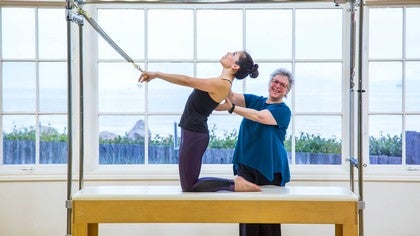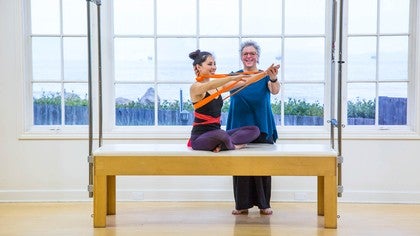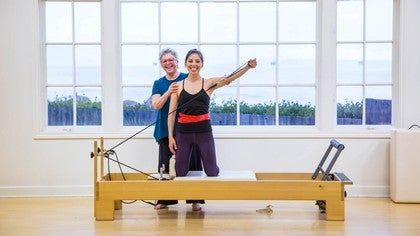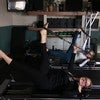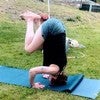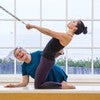Description
About This Video
Transcript
Read Full Transcript
So this tutorial we're going to be talking about the Latissimus Dorsi. And throughout this whole series we've been talking about shoulder stabilization. And one of the problems I hear in a lot of classes, whether it's dance, fitness, yoga, [inaudible], is pull your lats down. The lats are very, very important muscles, but they don't stabilize the shoulder girdle. They are really important for gate and they help stabilize the sacrum with your gluteals. So the lat attaches to the arm bone and then it goes down towards the sacrum.
So if the problem is like when I do this movement, I am using my lat, but I don't want to shorten it as I walk. And then if I'm pulling down too much in shortening, it can either pull my back into extension or for some people, depending on where they're pulling, it's going to pull the whole shoulder blade in downward rotation. Now we're gonna look at, um, our colleague here. So turn this way and I'm putting that here for you and I want you to watch when she pulls down through her lat. So you're going to go here. And if, and she, I don't know if you can see it through the camera, but it's fired up and you see how the shoulder blade is abducting into line. So now we're gonna look at how the lat looks when you're pulling down too much profile.
So a face to the side and here's where there's a scapula is, and if she's pulling down again, do you see how it's adducting and the shoulder blade is going into downward rotation. Now face forward. So we're going to bring in some of the principles that we've been talking about of getting upward rotation. We've been talking about that were ever, the hand is in space. The scapula is moving in the same direction. So you're going to bring your arm up and you're going to bend your elbow. So I wanted, so she's doing a great job.
That shoulder blade has moved forward. If I brought it, well, it's backwards. Let's do the other side so they can see and face them again. Profile. So there's that shoulder blade wrapping around the ribs and that's what we want to be always working with. And notice when she does that, that drops the shoulder blade. Now she's gonna grab whole, she's going to bring her elbow forward and she's going to hold it and she's going to lightly bring the humeral head back. So what we're trying to do is to get the center of the humerus bone into the socket without pulling down or abducting.
And then she's going to feel a little energy of the tip of the shoulder blade moving to the elbow. So it's kind of circular. So even if she was, if we brought her arm up and she was depressed down like, so that would be part of a lat thing. We want her to keep her shoulder blade a little wider, especially in this part of being front space. When she comes to the back, we're going to first get to see how much we could get that shoulder blade wide, how much she could move her arm back into space without moving the shoulder blade. Then we want her to move her shoulder blade. Then if she were let, we're, let's say we're gonna show you in, down, um, uh, Archie back.
And we have to get that primary and she's lifting up through and she's still, if I put my hand here, press slightly down, she has to lift up. So let's have you lie prone head this way. And the other thing we talked about in early tutorials is with the shoulder girdle. I want you to visualize the shoulder girdle wide. So we're now gonna look how the lats are in prone. I first want you to see that her shoulder blades are in a really nice wide position and her clavicles are wide.
And what I want her to try to find is how to bring her arms to our sides, trying to maintain the width of a shoulder girdle. So bring your arms down by your sides. And right now sometimes what happened, she's even doing it now. She's trying to pull her armpits down and I want her just to feel, think about her clavicles being wider and she's going to give me a little spinal extension. There we go. She's going to start lifting her arms up. That's begins that lat.
You can even feel that. And then she's going to give me more spinal extension. Spinal extension has to be primary, and then she's going to extend more and give me more lifts. She can come up higher she wants, but she's doing primary spinal extension and then lat. Now I want you to watch what happens a lot of times, the first movement you see is you see them pulling the armpits down and then when they come, she's good. But if I had a guy who was round shouldered like this, a pretend your round shoulder and try to come up, they're going to try to come up more through here because they don't know how to articulate through the spine.
What I want you think most importantly is like when the man does the iron cross, that's phenomenal use of the lats, but he has to have primary his core in his legs. If he doesn't have that, he will not be able to do the iron cross. And so we're gonna just do it one more time. So visualize the clavicles. Why visualize the shoulder blades they heared wide on the ribs first.
Give me more spinal extension. Let that breastbone slide forward. She's going to lift her arms up, she gonna give me more spinal extension and she now can pull and really activate those lots. And she's going to give me more left side. There you go. And then let it go. So we're now gonna move it and look at this, how the lots are working in chest expansion and thigh stretch. So come up to Neil, Stan and come forward. Great.
Now I want again, I can see a little bit and if you are a teacher, you just put your hands on there, a side bodies and you kind of listen and I feel some tone coming in, which is more lat. So I feel this coming in. So I want her to visualize that clavicle has little, little balloons on it and it's floating. And so what we want her to do is that the arm is moving back, but the shoulder girdle stays wide. So press the arms down and, but the armpits stay up. Keep going, keep going. There we go. And that's a really, that's really lovely. That's great. Yes, it's working. But you can see that she kept it at length. Now lets show bad version and do you see how she pulls down?
And then that shoulder blade add ducks in if you were doing chest expansion on the reformer, because this has less movement only when the arms go behind you. So just take your arms off and let's say you had ropes as she presses back. Yes, as she gets back she gets it. But she's keeping her clavicles up. Now let's do bad version where she pushes, she does downward rotation.
You can see it's also beginning to change the spine. Now we're going to look at thigh stretch. So remember when we did it prone, we had to have primary getting that spinal extension. So all these vertebrae needs a slide together and then she's gonna go back into thigh stretch. So she's going to lift up, she's going to feel the vertebrae move in and they're all moving equally. Good hamstrings. Now go back, she lightly pressed down. There we go. And then again its primary coming back up and lifting through.
And so again, you're going to coil the notch, your armpits. Visualize your clavicle high and wide on your back, right in this center line. We want those vertebrate a kiss into the center and then she's gonna press down and she's going to coil more in an arch and more legs. Get more legs. There you go. And then you're going to arch up, lift up your breastbone. And then there she is. Great. So now we're going to, you know, give more choreography.
So lift up your breastbone and her clavicles are wide. She's first going to start with chest expansion. She's doing a great job cause there's a shoulder girdle is wide. Press back more. Then she's going to coil her spine in, arch it up, lift her breastbone up, and then lean backwards at her hips and knees. And then she's gonna coil that spine back in her shoulder blades are still wide and then she releases and come through.
So we're gonna look at cat and camel. But I wanted also review a really wonderful imagery because sometimes the shoulder girdle is not in the right place because of the spine. And we're going to go a lot more through the um, next tutorial, bat that. But here's her clavicle. And right here is down. Here's probably first rib comes around first rib and it comes there.
So if you look at my collar, that's where your first rib is. So it's like having a necklace. So can she float that up? That's beautiful. Another great cue is visualize that the front of your armpit is coming up and that also just doing that movement helps her drop that shoulder blade and you see she already widened her shoulders. So we want to bring this underlying concept into a cat and Campbell. So come up to Neil stem and we want her to visualize her first rib. It's like you're, it's your slinky and we're just making all the ribs lengthen up.
The tip of the shoulder blade is just reaching towards her elbows and I want her to keep that spatial intent. So she's gonna pull her elbows down, but her first rib stays up high and then she, I call it motorcycle risks. Very important concept there. There you go. You're gonna roll. She's gonna keep the clavicle wide and then I want her stay move the tip of the shoulder. So right now she pulled down, I want her to move the tip of the shoulder blade towards the tower bar. There you go.
And then you're going to roll back up and you're going to lift back up and then you're gonna bring the whole thing back and bend through. So one of 'em Bonnie Bader, Colin's, which is somatic person, has a wonderful image about currently. And it means that like when we want to get the deep muscles of the spine to current in, but the lats need to current long away from the center. Okay. So she's going to pull down motorcycle risks so that, there we go. And then as she rolls down, I want her to lengthen that tip of the shoulder blade way. So I want, she is using her lad here, but she needs to learn to lengthen.
She's pulling down a lot. There we go. There we go. And then you're gonna roll the whole thing back and you're going to bring the whole thing back up and then you're going to, there you go and then bend your elbows, do it again. We're going to do a little worst bad version. So what happens when they pull down, go ahead. Isn't sometimes when you see the lat round down, it's almost, you see they're shortening from the armpit to the hip and then they can't get into the core as well. Kind of the belly kind of bulges.
And then she's having to come up a little higher. We want to get our clients to find extension, especially in our culture right now, all this flection and then she's going to roll back up. So the whole idea is to start visualizing this length even though when she pushes through, she's using it. So I want to review what motorcycle wrist is. So the idea is to try to move the arm as one parallel line.
And when people flex it, the wrist, you see, I start already sending my elbow out and I'm getting into internal rotation. So it kind of helps the shoulder mechanics. And, and the body rhythms to try to keep your risks as as possible so that you're moving more from your, your lat and your tricep than what you do at the risks. So let's look at that. Let's do matter of fact, do bad version. So pull down. So do you see she has to open her elbows out and then it's also gonna change the shoulder blade. And then again you might say, Oh, I should have my shoulders down. So then let's look at, she's her shoulder blades is at a very good place.
Can she move with as parallel arms as she can and there's the motorcycle wrists up and over. And do you see it keeps the alignment of the arms better? Roll through tip of the shoulder blade moves away from the hip socket. Wonderful. And then keep this, we want this, she is using her lats, but I want her to visualize this line stays long and she's gonna roll up. Go ahead and visualize. You're going to lengthen your arm pit away from your hip socket, your first rib away from your hip socket and lengthen up.
So I just want to review, come to sitting for me. Please profile what the importance of the lot is to do as well as if I'm pulling down too much. You can see that she's starting to hyper extend and then you, then you think, oh, I better fix it and pull my ribs down. Then you see creates another problem. My shoulders are forward. Then the other issue for some other people is they, it pulls an internally rotates there and they're becoming confided and then if she, let's say this line was really tight and she lifted her arm up and she tried to go back more, she's going to go arch through there.
So it's trying to find and teach your clients the importance of the lot, but also discovering its length through movement can really help the function of the shoulder girdle and the spine. The next tutorial, we're going to start talking about how to put this altogether and also the support for the spine, which is essential of how it brings a shoulder girdle.
Embodied Anatomy: Upper Body
Comments
You need to be a subscriber to post a comment.
Please Log In or Create an Account to start your free trial.
